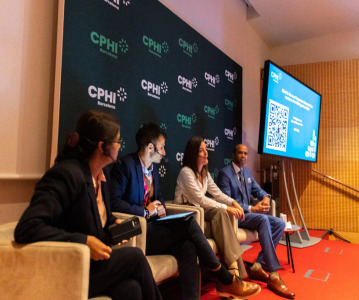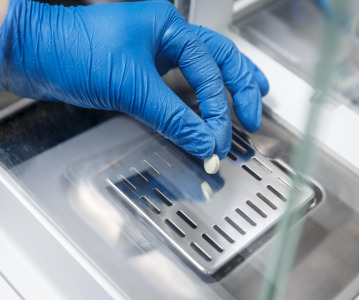Eight current drivers of the API production revolution

Manufacturing of active pharmaceutical ingredients has always been about innovating to cater for shifting demand patterns, but the recent coronavirus pandemic has raised further questions about whether the sector is doing enough to eke out efficiencies. Here we list eight major trends and considerations as API production enters a new age...
Even before the coronavirus pandemic, API production was undergoing a revolution. Shifting pharmaceutical industry demand had prompted manufacturers to innovate to expand the range and complexity of ingredients they can produce.
COVID-19 has simply accelerated this process. For example, supply chain disruption has amplified existing concerns about over reliance on a limited pool of API suppliers which, in turn, has prompted a wave of investment in production capacity in the US and EU.
1. Shifting demand
The API sector has its origins in the chemical industry of the nineteenth century. However, the modern fine chemicals sector was born in the 1970s with Smith Kline & French and Glaxo’s supply contract (1) for the ulcer drug Tagamet (cimetidine hydrochloride) usually cited as the catalyst (2).
Until recently the sector’s approach to production reflected its origins. Manufacturing techniques and technologies were developed to support volume production, which suited the volume-focused pharmaceutical industry.
But in recent decades, the situation has changed. The ‘patent cliff’ (3) - which saw pharmaceuticals that previously brought in billions in revenue lose patent protection opening them up to competition – prompted drug makers to refocus product development efforts. Instead of creating medicines for diseases impacting large populations, a significant number of firms pivoted to developing more complex, harder to copy drugs, many of which are for smaller populations.
2. Value not volume
These changing dynamics impacted the API sector, particularly in terms of its approach to manufacturing. Initially, the growth of the generics sector prompted suppliers to invest in capacity to cater for the surge in demand.
More recently, the focus has shifted. Increased competition has prompted many generics companies to try and differentiate products with modified formulations or novel delivery technologies. In response, API suppliers have invested in the capabilities needed to produce these complex, higher value actives.
API companies supplying innovative drug companies have also been changing manufacturing methods. Many have reduced capacity and invested in technologies needed for the novel chemistries required to make the new, more complex therapies that dominate industry production pipelines.
According to Molly Bowman, director of Clarivate’s generic and investigational drugs unit, “There is the continued demand for quality and reliability of supply. New specialized products favour those [suppliers] with facilities capable of handling them, driving companies to invest in upgrading and expanding or new facilities.”
3. Continuous flow
Continuous flow chemistry is one of the most active areas of innovation in API production. In contrast with batch-based methods, continuous reactions are performed in a tube or pipe, often in a micro-reactor. Reactants are mixed at a junction with the products flowing away in a constant stream.
In general, such reactions are faster, safe and result in ‘cleaner’ products. While these characteristics are important, the primary advantage of continuous flow chemistry from an API production standpoint is that it increases the range of chemistries that are possible.
According to analysis (4) by researchers at the University of Graz in Austria, the API sector’s use of the small internal volume “microreactors and their high surface area-to-volume ratios enable reactions to be run under conditions not easily accessible in traditional batch reactors.”
“Furthermore,” the authors write, “reactions previously impractical (‘forgotten chemistry’) or virtually impossible (‘forbidden chemistry’) to perform can be operated in these devices with little risk at various scales.”
4. Process control
Use of continuous flow chemistry has also prompted API manufacturers to invest in process control technologies and adopt the advanced analytical methods and technologies that underpin such systems.
A recent study (5) cited the increasing use of gravimetirc analysis – a mass-based characterisation method for chemical analytes – as an example. According to the researchers, the approach provides the same assurance of product quality and process control as spectroscopic measurements for control of drug content in a fixed-dose combination (FDC) and for identification of non-conforming material.
They wrote: “As pharmaceutical companies continue to push toward operational simplicity and sustainable manufacturing processes, soft-sensor and gravimetric controls as alternatives to their spectroscopic counterparts will be applied more broadly for process monitoring and control.”
5. High potency APIs
Pharmaceutical industry demand for high potency APIs has increased markedly in recent years. Partly this reflects continued interest in cancer therapies, according to Bowman, who says: “while there has been an increased demand for antibiotics, respiratory and antivirals, cancer drugs continue to be the focus of R&D.”
More recently, highly potent APIs have started to be used in targeted therapies for respiratory, hormonal, cardiovascular and central nervous system disorders.
Growing demand for potent APIs has prompted change in the supply sector. Manufacturers targeting this demand have had to invest in additional containment technologies, safety equipment and risk management processes to ensure safe handling.
6. Lyophilisation
Lyophilisation is another area of investment for the API manufacturing sector. According to analysis by Global Market Insight, the market for industrial lyophilisation equipment will be worth $9billion (6) by 2026, up from the $5 billion it was worth in 2019 (7).
The analysts predict pharmaceutical industry use of lyophilisation technology will increase significantly over the period, citing rising demand from protein-based drug developers coupled with increased freeze drying of APIs will drive the segmental growth.
“Bulk drying of API is performed through the process of lyophilization in order to achieve the chemical stability of active pharmaceutical ingredients that will positively impact the industry growth,” they wrote.
They also said biopharmaceutical products like Infliximab, Rituximab and Etanercept – all of which undergo lyophilisation during production - “will further lead to industry expansion over the forecast timeframe.”
7. Pandemic
The COVID-19 pandemic has impacted all aspects of modern life, API manufacturing included. The initial impact was disruption. The outbreak prompted several countries to restrict the exportation of certain drug actives over concerns about domestic supply.
In March (8), India temporarily banned API firms from shipping 26 drug ingredients and medicines made from them citing the disruption of China’s chemical manufacturing – which supplies 70% of the sub-continent’s actives – as a major worry.
The Indian Government lifted the export ban a month later (9), explaining it would allow exports of those products in “appropriate quantities” to nations who have been particularly badly affected by the pandemic.
In the months since, the disruption has reduced and supply chains have stabilized. According to Bowman, “following an initial disruption of global API supply chains as a result of closing borders and regional lock-downs, much of the supply chains seem to be returning to normal.”
8. Local manufacturing
The disruption caused by the pandemic has amplified existing concerns (10) about the pharmaceutical industry’s reliance on APIs made in China.
In October 2019 (11), just a few months before SARS-CoV-2 was detected, the US Food and Drug Administration wrote “use of foreign-sourced materials creates vulnerabilities in the US drug supply.” The agency urged policy makers to move to bolster local production.
In Europe the situation is similar. In March the European Commission said dependency of the EU pharmaceutical industry on active pharmaceutical ingredients and chemical raw materials imported from third countries represented a supply chain risk. (12) This was reiterated in the strategy document published in November (13), when the Commission said boosting local API production should be a focus.
And the API sectors in major markets have started to take note, according to Bowman.
“In an effort to avoid disruption in the future, numerous countries such as Japan, US, India and the EU are incentivizing and crafting legislation to encourage local manufacturing,” she says. “Companies such as Sanofi have launched initiatives to help secure API supply and manufacturing capabilities that are crucial for patients in Europe and beyond.”
Gareth Macdonald
References:
- https://www.acs.org/content/acs/en/education/whatischemistry/landmarks/cimetidinetagamet.html
- https://cen.acs.org/articles/83/i25/Tagamet.html
- https://www.ncbi.nlm.nih.gov/pmc/articles/PMC4899342/
- https://www.teknoscienze.com/Contents/Riviste/PDF/CO3_2015_LOW_20-27.pdf
- https://link.springer.com/article/10.1007/s12247-020-09498-2
- https://www.gminsights.com/pressrelease/lyophilization-equipment-market
- https://www.gminsights.com/industry-analysis/lyophilization-equipment-market
- https://www.reuters.com/article/us-health-coronavirus-india/global-supplier-india-curbs-drug-exports-as-coronavirus-fears-grow-idUSKBN20Q0ZZ
- https://www.reedsmith.com/en/perspectives/2020/04/india-reverses-pharmaceutical-export-restrictions-shortly-after-imposing
- https://www.bis.doc.gov/index.php/documents/other-areas/642-department-of-homeland-security-dhs-assessment-impact-of-foreign-sourcing-on-health-related-infra/file
- https://www.fda.gov/news-events/congressional-testimony/safeguarding-pharmaceutical-supply-chains-global-economy-10302019
- https://ec.europa.eu/health/sites/health/files/files/committee/ev_20200312_795_en.pdf
- https://eur-lex.europa.eu/legal-content/EN/TXT/?uri=CELEX:52020DC0761
Related News
-
News CPHI Milan 2024 - From the Floor
Milan and CPHI welcome you to 2024 CPHI Milan! As we celebrate the 35th edition of our flagship CPHI show, editors Vivian Xie and Lucy Chard bring you the latest from the show floor, conference sessions, and innovative solutions from all exhibitors, at... -
News The BIOSECURE Act: implications for the pharma supply chain
On September 9, 2024, the US House of Representatives voted to pass the bill titled the BIOSECURE Act (the Act), which lists several Chinese companies in the pharmaceutical supply chain. The Act will prohibit American companies from contracting or doin... -
News A Day in the Life of a Global CDMO Chapter Lead – Manufacturing
The 'Day in the Life of' series has covered many aspects of the pharmaceutical pipeline, including R&D and procurement, now we're taking a look at manufacturing from a global CDMO perspective. -
News CPHI Milan Speaker Spotlight: CDMO relations with Pharma and Start-Ups
In the run-up to CPHI Milan, we sit down with some of the experts and thought-leaders speaking at this year’s conferences. -
News Women in Pharma: Advocating for trans healthcare in pharma
In our monthly series on women in the pharmaceutical industry, we interview leading experts in the pharmaceutical supply and value chain to discuss the importance of gender diversity in healthcare, the workplace, and beyond. -
News Updated – Changing abortion pill access according to the US FDA and Supreme Court
After the approval of the medical abortion pill, mifepristone, by the US FDA, states across the USA approach the distribution of the pill differently, some ruling against allowing access to the drug. -
News CPHI North America 2024 – From the Floor
Welcome to Philly! CPHI North America once again graces the Philadelphia Convention Center, 7–9 May 2024. -
News Drug Patent Expiries: a steep cliff or opportunity for innovation?
The pharmaceutical industry faces a patent cliff together in the years leading up to 2030. Learn what this means for drug pricing, their outsourcing partners, and drug innovation of the future.
Recently Visited
Position your company at the heart of the global Pharma industry with a CPHI Online membership
-
Your products and solutions visible to thousands of visitors within the largest Pharma marketplace
-
Generate high-quality, engaged leads for your business, all year round
-
Promote your business as the industry’s thought-leader by hosting your reports, brochures and videos within your profile
-
Your company’s profile boosted at all participating CPHI events
-
An easy-to-use platform with a detailed dashboard showing your leads and performance




.png)


.png)